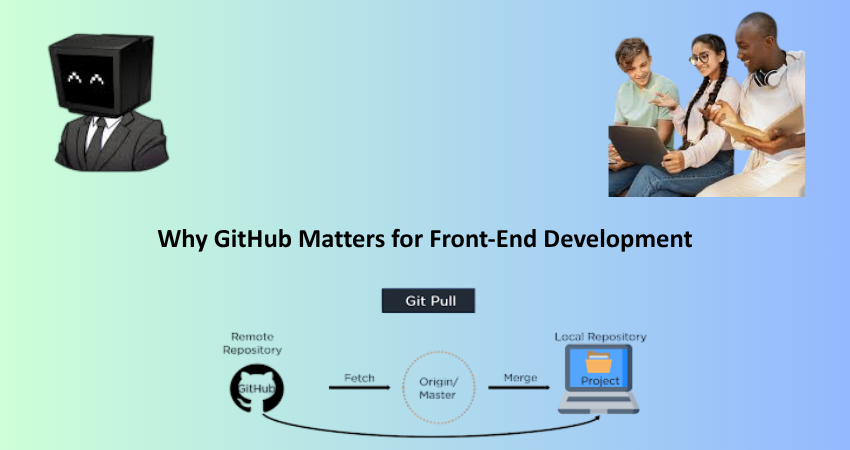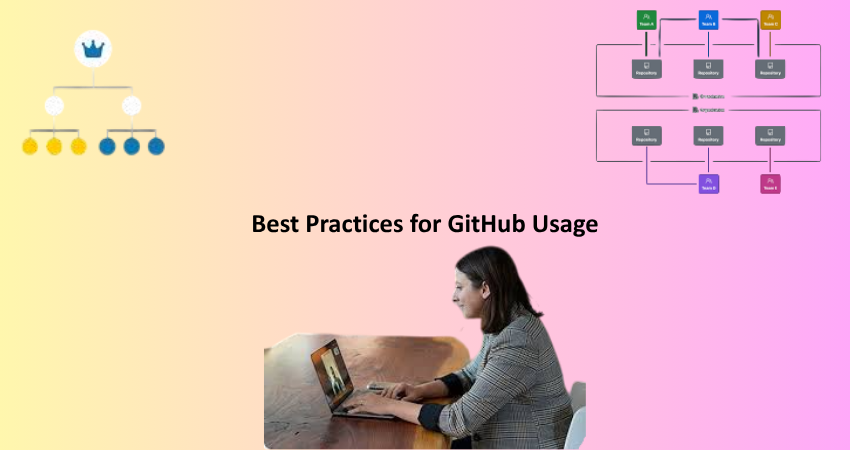
Introduction
In today’s world of Web development, teamwork and version control are important practices that ensure the flow of work; thus, putting out high-quality code. GitHub is one of the primary platforms that these procedures rely on. A web-based system built on Git, GitHub provides means for developers to store codes, track changes, manage collaborative works, and deploy their applications. Though traditionally an ally to open-source projects and back-end systems, it is becoming increasingly important for front-end developers. From interactive interfaces to static websites and complex single-page applications, knowing and using GitHub can provide a big boost to your development.
Well, there are junior and aspiring front-end developers, but GitHub seems scary for most and is just for back-end developers. In reality, GitHub is important for every stage of front-end development-from sharing code with peers and managing pull requests to exhibiting the portfolio and being involved in a bigger community of developers. Because great big scalable collaborative front-end projects are highly in demand these days, familiarity with GitHub is no longer a nice-to-have. This article will discuss what GitHub basically is, how the whole thing works, and why it is particularly important for front-end developers in present-day tech ecosystems.
Understanding Git and GitHub
What Is Git and How Does It Work?
Gitted provide a distributed version control systems, helps developers to keep track of the progress in software development-source code. Developed by Linus Torvalds and made public in 2005, Git allows developers to work alone or together on a detailed history of every code change. In contrast to shed version control systems, branches and work on full-level copies of the project history in a separate manner; an alternate feature that assists in holding advanced offline work and branching in projects. Simply put, the distributed is Git powerful and flexible.
Basic operations of Git involve repository creation, staging of changes, committing updates, and branch management. It is a folder that contains files belonging to the project along with the entire history of revisions. Software developers can further branch the work and check new features without a possibility of modifying the main code branch and merge, once the code has been vetted and approved. These core operations are why Git is indispensable for any development process that changes frequently, involves collaboration with others, or requires rolling back changes made. Even a small project done on one person’s behalf derives much benefits from all the safety net and structure that Git provides.
GitHub as a Platform: Features and Benefits
Git serves as the backbone version control while GitHub comes with its own web-based agenda that extends Git’s capabilities by adding about a dozen features including issue-tracking, project boards, pull requests, and team management. It is also synonymous with centralized hosting of the Git repositories, thus simplifying the process of code sharing and collaboration. GitHub adds an aesthetic layer, rendering the activities of comparing branches, reviewing commits, and managing contributor roles within an individual-themed yet user-friendly interface.
Pull request made GitHub the apple of many developers’ eyes because it enhances code review and collaboration. Before being merged into the main branch, front-end developers can apply for changes through pull requests that would go through a teammate or manager for approval or discussion. It integrates with all CI/CD tools, automating the testing and deployment pipeline. Other than these, GitHub has a more gracious acknowledgment of the stars, forks, and contributions toward open source repositories: indeed vital for a front-end developer’s professional footprint. The GitHub umbrella is always over the head of a front-end developer, be it solo working or within a team, to ensure productivity, code quality, and visibility with the project.
Why GitHub Matters for Front-End Development

Facilitating Team Collaboration and Code Review
Collaborative front-end projects generally involve designers, developers, and stakeholders. The collaboration through common repositories, branches, and pull requests is where GitHub stays in the foreground. Developers can work on individual features or bugs in separate branches, leaving the main codebase unscathed. Upon completing the task, the developer has to create a pull request for review, comment, suggest changes, or approve from other developers. This assures peer review and that the code being merged meets the standards agreed upon.
With issue tracking and discussions, the teams can maintain even higher transparency and accountability for their achievements. The developers create issues for bugs, feature requests, enhancements, and assign them to their peers for implementation. This further smoothens the workflow without redundancy. Besides, project boards can be accessible and usable in a way like Trello or Jira to visualize progress and manage transition. All these ingredients together make GitHub an indispensable place for front-end collaborative development, especially when Agile or Scrum methodologies are applied. Whether you’re freelance or you’re a full-time member of a tech house, learning such collaborative tools will act as a significant boost to your contributions as a team player.
Maintaining Code Quality and Version History
At the front end, quality coding matters because it speaks more to better user experience and performance. GitHub version control feeds that contractor into the scenario and allows developers to stay tuned to breaking changes within the code base. The history is ideal for debugging and accountability purposes since it shows who changed what and why. By doing so, should a bug be introduced, it is always possible to fall back to a previous commit, thus saving time and trouble. The audit trail created is invaluable in fast-paced projects with constant updating.
Besides these, front-end teams may also use branch protection rules and status checks to enforce code quality standards. For example, merging may be denied unless code passes certain pre-defined automated test cases or several other teammates review it. The workflow can be entwined with linters, formatting tools, and unit testing frameworks to catch problems before they ever go into production. When done consistently, this fosters a culture of code integrity and professionalism that your organization will champion. As front-end applications increase in complexity, realizing that GitHub holds altogether not just organization but the trust and reliability of your codebase will come in handy.
Leveraging GitHub for Personal Growth
Building a Portfolio and Showcasing Skills
For the most part, a shiny new portfolio works wonders for the early careers of front-end developers, and GitHub is just that. Unlike a resume or portfolio, it evolves, serving as proof of the skills you have been honing, the projects you have done, and the contributions you have made. It thus tests your performance with coding, problem-solving approaches, and styles of collaboration.” These kinds of scrutiny would delve into the GitHub profile of candidates before making any hires, and a very good impression can be made by such a well-maintained profile-from clear commit messages to detailed README files and varied projects.
Use your GitHub portfolio to its maximum by working on worthy projects of diverse areas in front end development. Some of them include responsive landing pages, JavaScript games, single-page applications with react or vue, or contributions to existing open-source projects. Make your repos more professional and accessible with documentation, screenshots, and even precise setup instructions. Pinning the best ones in your profile along with tagging or folder arrangement of their stored repositories further enhances usability. The management of your GitHub profile continually adds value to the credibility of your profession and will always make you stand out among other contestants in the open job market.
Contributing to Open Source and Community Learning
Open source projects throng GitHub with thousands of possibilities for developers at all skill levels. Participation in open source is, in fact, a great opportunity for learning. It exposes front-end developers to various codebases, coding standards, and best practices of seasoned professionals. Most importantly, it builds the environment for the best hands-on experience needed in real-world development coordination, teamwork, communication, and version control. These experiences constitute perhaps the most valuable form of learning system that goes far in aiding your development and boosting your confidence, even beyond project-oriented tutorials.
Contributing is not only about writing new features: code reviews, bug fixes, documentation updates, or anything that makes a project more accessible are also very important contributions. Many projects have beginner-friendly tags like good first issue or help wanted, which make getting started easier. Participating in hackathons and events, such as GitHub’s Hacktoberfest, can also be a great way to learn how to contribute and connect. In time, all your contributions will build a visible history tracking your involvement and growth as a developer. Contributing to the open-source community refines your skills and opens avenues to mentors, collaborators, and potential employers.
Best Practices for GitHub Usage

Structuring Repositories and Writing Good Commits
A well-formed repository is easier to follow and understand. Well, it means that a front-end developer should organize files into separate folders such as components, assets, and styles. It is important also to have a README on it explaining what the project does, which technologies are used, how to set it up, and any other notes. A README file will now function as a first impression and a user manual for your code. You can even add more value to the repository with a LICENSE file, a CONTRIBUTING guide, and badges for test or deployment status.
The ability to write good commit messages is also an important skill. A commit should represent a single logical change, with a concise, descriptive message. Following a convention, like Conventional Commits (feat: add responsive navbar), makes it easier to read and paves the way for automated changelogs and release scripts. Do not leave vague messages like “update” or “fix” without context. Commits should be as atomic and frequent as possible to ease tracking and debugging. Over time, it become second nature to maintain clear repositories and clear commits, added to the fact that such is a show of professionalism to whoever looks at one’s work.
Securing and Managing Your Projects
Security goes hand in hand with project management on GitHub. In a public repository, for instance, you would commit all the APIs, passwords, and private configuration files; therefore, you’ll need to remember to say “no” to these commits. Exclude environment-related files by using .gitignore and consider utilizing the secret scanning feature by GitHub to catch accidental leaks. It limits the number of unauthorized changes and maintains code integrity by setting roles and access levels when working on group projects.
Project management capabilities such as dealing with issues, creating milestones, and having GitHub Projects boards help structure workflow for development. Example: Planning features to track bugs and assigning tasks to an employee. You can also create a context and history that is more trackable by linking pull requests to issues. Works very well by integrating Slack or Trello with GitHub. No pull request goes unnoticed because of notifications and requests for reviews, thus keeping the timelines set for development on track. Whether working for yourself or part of a contribution, responsibility through security and project tools goes with GitHub and makes for smooth and secure development.
Conclusion
It’s not just repository host, but a collective ground, a personal portfolio and a professional toolbox of every frontend developer that helps them write some badass codes, work with others more efficiently and advance in their careers. If they’re aware of the core features of GitHub and follow some best practices or tips, the productivity, quality of code, and marketing could go a long way for frontend developers. From version control and team collaboration to portfolio building and open-source contribution, GitHub presents unlimited opportunities for leveling up your development journey.
In fact, as an ever-changing digital world, so it is important that a front-end developer adapts using tools that support a more modern workflow-the most prominent of which is GitHub. Early mastery of this great tool-using it well-will not only save you from the headaches brought about by project structures, but also prepare you to enjoy the fact that software development projects have an established collaborative nature. Coding by yourself through a couple of tutorials, or understanding his contribution in a team or community, would be a gist of having GitHub at the core of your success as a front-end developer.